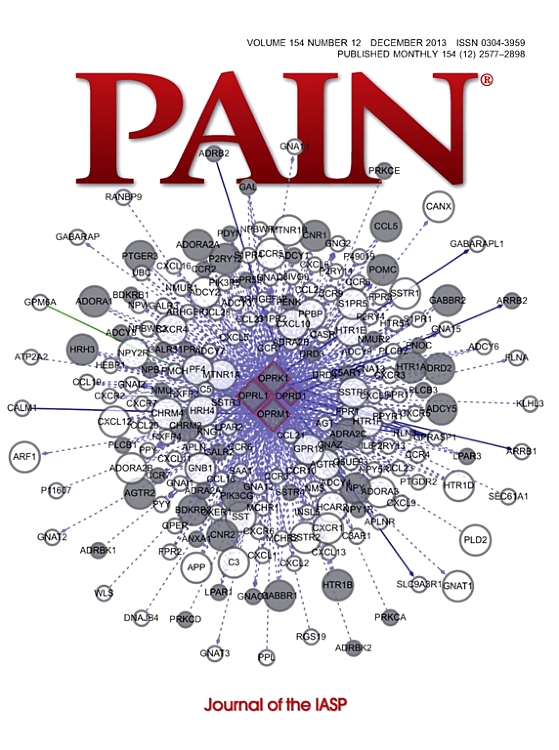12/15-脂氧合酶介导雌性小鼠toll样受体4依赖性致伤性疼痛超敏反应。
IF 5.5
1区 医学
Q1 ANESTHESIOLOGY
引用次数: 0
摘要
慢性伤害性疼痛综合征的特点是外周和中枢神经系统的敏感化,在女性中发病率增加。然而,非甾体类抗炎药对减轻伤害性疼痛无效,目前的处方治疗,如阿片类药物、抗惊厥药和抗抑郁药,对这些适应症的治疗效果有限。在目前的工作中,我们将先前的研究扩展到雄性和雌性C57BL/6N小鼠的中枢toll样受体4依赖性疼痛过敏大鼠,发现雌性小鼠鞘内脂多糖(LPS)后出现意想不到的痛觉过敏表型。与之前报道的雌性C57BL/6J小鼠相比,雌性C57BL/6N小鼠在对IT LPS的反应中表现出触觉和冷异常性疼痛、握力缺陷和运动活动的适度增加。与我们之前在雄性大鼠中的观察一致,LPS在雌性C57BL/6N小鼠中释放了脊柱12/15-脂氧合酶(12/15-LOX)代谢物(12/15-LMs)。同样,12/15-LOX酶在与伤害性传递相关的多种组织和细胞类型中基本表达。选择性抑制剂ML355(靶向12-LOX-p)或ML351(靶向15-LOX-1)对雌性C57BL/6N小鼠的12/15-LOX的全身抑制完全逆转了异常性疼痛和握力缺陷。12/15在痛觉过敏启动模型中,当以阈下剂量给药脊柱(IT)或外周(脚掌足底)时,lms也会产生触觉异常性痛,类似于其他人对环氧化酶代谢物前列腺素E2的阈下剂量的观察结果。总的来说,这些数据表明12/15-LOX酶有助于啮齿动物的外周和中枢疼痛超敏反应,通过多种反射性和功能结果测量,具有跨性别和跨物种的潜在可翻译性。本文章由计算机程序翻译,如有差异,请以英文原文为准。
12/15-lipoxygenases mediate toll-like receptor 4-dependent nociplastic pain hypersensitivity in female mice.
Chronic nociplastic pain syndromes are characterized by sensitization of peripheral and central nervous systems and exhibit increased incidence in women. However, nonsteroidal anti-inflammatory drugs are ineffective in mitigating nociplastic pain, and current prescription treatments, such as opioids, anticonvulsants, and antidepressants, provide limited therapeutic benefit for these indications. In the current work, we extended previous studies in rats of central Toll-like receptor 4-dependent pain hypersensitivity to male and female C57BL/6N mice, uncovering an unexpected hyperalgesic phenotype in female mice following intrathecal (IT) lipopolysaccharide (LPS). In contrast to previous reports in female C57BL/6J mice, female C57BL/6N mice displayed tactile and cold allodynia, grip force deficits, and a modest increase in locomotor activity in response to IT LPS. Congruent with our previous observations in male rats, LPS released spinal 12/15-lipoxygenase (12/15-LOX) metabolites (12/15-LMs) in female C57BL/6N mice. Likewise, 12/15-LOX enzymes are basally expressed in multiple tissues and cell types relevant to nociceptive transmission. Systemic inhibition of 12/15-LOX in female C57BL/6N mice with selective inhibitors ML355 (targeting 12-LOX-p) or ML351 (targeting 15-LOX-1) completely reversed allodynia and grip force deficits. 12/15-LMs also produce tactile allodynia when administered spinally (IT) or peripherally (paw intraplantar) at a subthreshold dose in a hyperalgesic priming model, similar to others' observations with a subthreshold dose of the cyclooxygenase metabolite prostaglandin E2. Collectively, these data suggest that 12/15-LOX enzymes contribute to peripheral and central pain hypersensitivity in rodents, with potential translatability as druggable targets across sexes and species using multiple reflexive and functional outcome measures.
求助全文
通过发布文献求助,成功后即可免费获取论文全文。
去求助
来源期刊

PAIN®
医学-临床神经学
CiteScore
12.50
自引率
8.10%
发文量
242
审稿时长
9 months
期刊介绍:
PAIN® is the official publication of the International Association for the Study of Pain and publishes original research on the nature,mechanisms and treatment of pain.PAIN® provides a forum for the dissemination of research in the basic and clinical sciences of multidisciplinary interest.
 求助内容:
求助内容: 应助结果提醒方式:
应助结果提醒方式:


